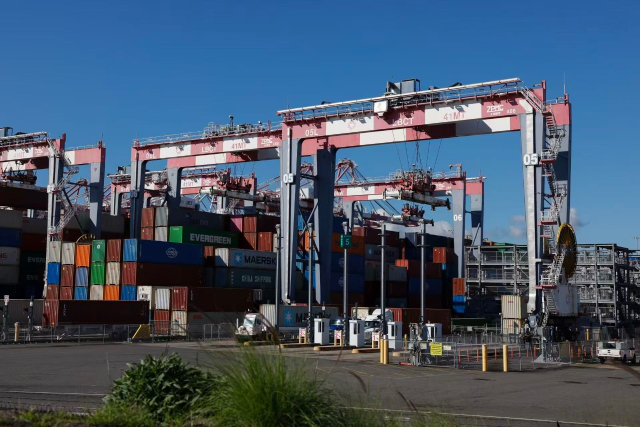The day before the U.S. imposed the port fee, China introduced its reciprocal charges on U.S.-flagged vessels. The figures—an estimated $34 million in annual U.S. collections—may seem modest compared to the overall U.S.-China trade. The message is not. Maritime commerce, once the quiet backbone of globalization, has officially entered the realm of strategic competition.
For decades, ports were the ultimate neutral ground. Now, they are being drawn into the same tug-of-war that has already engulfed technology, investment, and rare earth. The timing could hardly be worse. Since the London and Madrid rounds of dialogue, both governments have at least sent goodwill through discussions. Yet each attempt at stabilization has been followed by fresh confrontation—whether the expansion of Washington's Entity List or President Trump's dramatic threat to impose 100 percent tariffs on Chinese goods. The latest port-fee tit-for-tat only deepens the sense that trade diplomacy has become another stage for domestic politics.

Shipping containers are stacked at the Port of Los Angeles in Los Angeles, California, USA, 15 October 2025. The U.S. and China began charging additional port fees on 15 October 2025, on ocean shipping firms following China’s rare earth export controls in response to new trade restrictions imposed by the Trump administration. (Photo: CFP)
The United States' new maritime policy is not a one-off decision; it reflects a deliberate shift in economic statecraft. President Trump has long framed shipbuilding as a symbol of "national rebirth," a vision legally reinforced by the Big Beautiful Bill in July. The legislation funnels billions into defense procurement, promising to restore American manufacturing greatness through warship building. But numbers tell a different story. The U.S. produces less than one percent of the world's commercial vessels, while Chinese and Korean yards dominate global orders. Unable to close that gap quickly, Washington has chosen to project strength rather than rebuild it. Docking fees, presented as fairness, are in practice theater—a politically convenient signal that avoids the deeper challenge of revitalizing real industrial capability.
The irony runs deeper. Only a week before the fee announcement, the Trump administration blocked and delayed the International Maritime Organization's Net-Zero shipping framework, calling it an "unfair tax on American shipbuilders." Yet days later, it introduced a new charge on Chinese vessels—an act that underlines how "reciprocity" has become less about equality and more about optics. None of these gestures address the fundamental issue: America's shipyards are too few, its costs too high, and its dependence on allied builders in Japan and South Korea too entrenched to yield meaningful industrial revival through confrontation alone.
Washington's political narrative has been reinforced by years of congressional and think-tank advocacy. From the "China Port Network" thesis—portraying Chinese overseas port investments as latent security risks—to repeated hearings labeling China's shipbuilding scale as "strategic overcapacity," the idea that maritime logistics must be securitized has gained bipartisan traction. Once ports are viewed as extensions of national defense, ordinary business transactions can easily be repackaged as threats. The result is a spiral of suspicion: each regulatory move justifies the next, while the commercial logic that underpinned global shipping quietly erodes.
This approach also serves another purpose—market management. The Trump administration has consistently used uncertainty as an economic instrument. Tweets (or mostly Truths), tariffs, and surprise waivers are deployed not to correct structural weaknesses but to influence sentiment and timing. The same choreography now extends to maritime policy. A docking fee can move freight rates and insurance costs overnight, feeding inflation expectations and market volatility. When the White House later offers "clarification," it can claim credit for calming the very waves it stirred.
The real-world consequences are tangible. Shipping underpins 90 percent of global trade. A single additional charge at the pier may appear trivial, but when multiplied across thousands of voyages—combined with tighter inspections, higher insurance premiums, and policy uncertainty—the costs compound. Larger shipping alliances can reallocate routes and absorb losses; smaller exporters and developing economies cannot. In the end, American consumers—already sensitive to price fluctuations—will bear the added burden.
At the industrial level, these tensions will reshape maritime geography. Orders will continue flowing to East Asia, where shipbuilding efficiency remains unmatched. Port operators worldwide will face new geopolitical screening standards before securing financing or partnerships. And the growing classification of ports as "strategic assets" will raise borrowing costs, pushing private investors out and forcing heavier reliance on state-backed capital. Each of these shifts chips away at the resilience of the global supply chain.
If the United States truly intends to rebuild its maritime strength, it must look inward rather than outward. Modernizing its shipyards, training a new generation of maritime workers, and coordinating with partners on innovation would yield more than politically charged tariffs or fees. Industrial renewal requires patience and investment, not headlines. By substituting confrontation for construction, Washington risks weakening precisely what it seeks to restore—its ability to compete through production, not protection.
For China, the task is to weather these shifting tides with steadiness and foresight. Reciprocity can deter unfair treatment, but escalation serves no one. The priority should be to safeguard the openness of maritime trade through multilateral mechanisms—the International Maritime Organization, the RCEP framework, and global sustainability initiatives that emphasize transparency and rule-based cooperation. Just as crucially, insulating shipping finance and insurance networks from sanctions spillovers will help ensure that political shocks do not automatically become liquidity crises.
Ultimately, both sides must remember that supply chain stability is a shared interest, not a bargaining chip. Maritime logistics remains the circulatory system of the global economy, connecting factories, farms, and consumers across continents. Politicizing that system may score short-term points but risks long-term stagnation for everyone.
The danger ahead is not a single crisis, but a gradual normalization of friction—a world in which docking fees, inspections, and minor restrictions quietly accumulate into structural drag. When ports become contested terrain, ships still sail, but their routes grow longer, their cargoes more expensive, and the trust that once held trade together begins to dissolve.
The lesson is simple but urgent: economic resilience cannot survive perpetual turbulence. Stability—predictable, rules-based, and cooperative—is not a luxury but a necessity. As the world navigates through this uncertain current, protecting the openness of its sea lanes may prove to be the truest test of global leadership.
(*The article is written by Alan Zhang, Research Associate and Manager, Trade and Technology Program, Institute for China-America Studies)
















